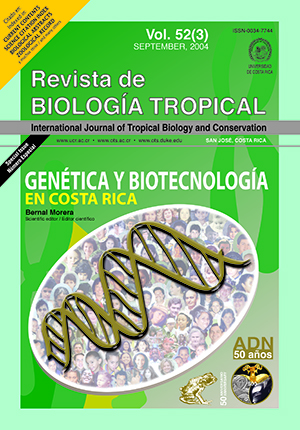Abstract
Band 3 (AE1) is one of the most abundant proteins in the membrane of the human erythrocyte. This protein works as an anionic CI - and HCO3- exchanger and it also functions as an anchor for several proteins of the erythrocyte's cytoesqueleton. Several mutations have been described and many polymorphic variants have been associated to hereditary spherocytosis. The identification of a genetic marker at position 5' of the AE1 gene could be associated to several molecular defects of the erythrocyte. This genetic marker is a restriction fragment length polymorphism (RFLP) produced by restriction enzime Pst I. For this polymorphism a total of 216 individuals belonging to seven different populations were analyzed: one from the Central Valley, two African descendants (Limón and Guanacaste) and four Amerindians (Bribri, Cabecar, Maleku and Guaymi). The most frequent allele in the Amerindian population was no 1. No significant differences were found with respect to the Hardy-Weinberg equilibrium in six of the populations, although the Guaymi group does present significative differences.References
Berne, R.M. & M.N. Levy. 1993. Physiology. Mosby-Year Book, St Louis, Missouri. U.S.A. pp. 20-21
Bruce, L.J., R. Unwin, O. Wrong & M. Tanner. 1998. The association between familial distal renal tubular acidosis and mutations in the red cell anion exchanger (band 3, AE1) gene. Biochem. Cell. Biol. 76: 723-728.
Delaunay, J. 1995. Genetic disorders of the red cell membrane. Critical Reviews in Oncology/Hematology 19: 79-110.
Jarolim, P., J. Palek, H.L. Rubin, J.T. Prchal, C. Korsgren & C.M. Cohen. 1992. Band 3 Tuscaloosa: Pro327ÆArg 327. Substitution in the Cytoplasmic
Domain of Erythrocyte Band 3 Protein Associated with spherocytic Hemolytic Anemia and PartialDeficiency of Protein 4.2. Blood 80: 523-529.
Jarolim, P., H.L. Rubin & S. Zhai. 1992. Band 3 Memphis: A Widespread polimorphism with abnormal electrophoretic mobility of erythrocyte Band 3 protein caused by substitution AAGÆGAG (Lys ÆGlu) in codon 56. Blood 80: 1592-1598.
Jay, L. 1986. Structural aspects of the Red Cell Anion Exchange Protein. Ann. Rev. Biochem. 55: 511-538.
Jenkins, P.B., P.G. Gaallagher & B.G. Forget. 1993. Analysis of a Pst I polymorphism of the human erythrocyte band 3 gene (EPB3). Br. J. Haem. 85: 816-818.
Lux, S.E., K.M. John, R. Kopito & H. Lodish. 1989. Cloning and characterization of Band 3, the human erythrocyte anion-exchange protein (AE1). Proc.
Nath. Acad. Sci. USA. 86: 9093.
Mailet, P., A. Valier & W.H. Reinhart. 1995. Band 3 Chur: and variant associated with band 3- deficient hereditary spherocytososis and substitution in a highly conserved position of transmembrane segment 11. Br. J. Haem. 91: 804-810.
Marguerite, M., B. Kay, J. Hughes, I. Zagon & Lin. 1991. Brain Membrane protein Band 3 performs the same Functions as Erithrocyte Band 3. Cell 88: 2778- 2782.
Miller, S.A., D. Dykes & H.F. Polesky. 1988. Asimple salting out procedure for extracting DNA from human nucleated cell. Nucleic Acid Res. 16: 1215.
Morera, B. & R. Barrantes. 1995. Genes e historia: el mestizaje en Costa Rica. Revista de Historia 32: 43-64.
Morera, B., R. Marín-Rojas & R. Barrantes. 2001. Análisis de varios marcadores genéticos clásicos en la población de Costa Rica. Rev. Biol. Trop. 49: 1237-1252.
Morera, B., R. Marín-Rojas & R. Barrantes. 2003. Gene Admixture in the Costa Rican Population. Ann. Hum. Genet. 67: 71-80.
Palek, J. & S. Lambert. 1990. Genetics of the Red Cells Membrane Skeleton. Sem. Hematology 27: 290-332
Sáenz, G.F., G. Arroyo, J. Jiménez, A. Gutiérrez, M. Barrenechea, E. Brilla & E. Valenciano. 1971. Investigación de hemoglobinas anormales en la población de raza negra costarricense. Rev. Biol. Trop. 19: 251-260.
Sáenz, G.F., G. Arroyo, M.A. Alvarado, G. Montero, J. Jiménez & E. Valenciano. 1974. Hemoglobinas anormales en una población estudiantil universitaria.
Rev. Biol. Trop. 21: 417-424.
Sáenz, G., M. Cháves & E.M. Quintana. 1986. Las hemoglobinopatias en Costa Rica aspectos históricos, culturales y epidemiológicos. Rev. Cost. Cien. Med. 7: 95-106.
Showe, L.C., M. Ballantine & K. Huebner. 1987. Localization of the gene for the erythroid exchage protein, Band 3 (EPB3) to the chromosome 17. Genomics 1: 71-76.
Stewart, E.A., R. Kopito & A.M. Bowcock. 1989. A Pst I polymorphism for the erythrocyte surface protein band 3 (EPB3) to human Chromosome 17. Genomics 1: 71-76.
Yannoukakos, D., C. Vasseur & C. Driancourt. 1991. Human Erithrocyte Band 3 polymorphism (Band 3 Memphis): Characterization of the Structural modification. (Lys 56ÆGlu ) by Protein Chemistry methods. Blood 78: 1117-1120.
##plugins.facebook.comentarios##

This work is licensed under a Creative Commons Attribution 4.0 International License.
Copyright (c) 2004 Revista de Biología Tropical


